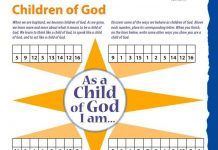
Grace-filled moments of encounter and union with God
MARC CARDARONELLA
Penance and Reconciliation: It’s also known as confession, as well as the sacrament of conversion and the sacrament of forgiveness. Dreaded by some, it’s the most tangible sign of God’s presence among us — outside of the Eucharist. Forgiveness, mercy, healing — these are hallmarks of Jesus’ ministry on earth. They continue to be an essential part of his ministry through the Church in this sacrament. How do you communicate this deep mystery to your students and prepare them for it? That’s what this article will explore.
In the introduction to the Catechism’s section on sacraments, there’s an image from the 4th century. It’s a fresco depicting the “woman with a hemorrhage” from Mark 5:25-34 as she touches the hem of Jesus’ garment. That touch released “power” from Jesus that healed her suffering when nothing else could. The caption reads, “The sacraments of the Church now continue the works which Christ had performed during his earthly life. The sacraments are as it were ‘powers that go forth’ from the Body of Christ to heal the wounds of sin and to give us the new life of Christ” (CCC, Part Two introduction).
To me, nothing illustrates the work of the sacraments, especially the Sacrament of Penance and Reconciliation, quite like this. Theology looks at grace and the sacraments in an objective way. I prefer to see them from a personalist viewpoint. The sacraments are encounters, moments of union with the Risen Christ. Grace is God’s very life given to us. When we receive grace, we’re sharing in God’s life — that is, his presence, his power. It’s transformative — a divine fire that consumes and remakes things into itself.
When you receive the sacraments, you contact the risen Christ through the power of the Holy Spirit and receive his life. The Lord lovingly seeks out what is imperfect in you — what is not Christlike — and remakes it. If your students see the sacrament this way, they’ll never again question why they should confess their sins to a priest. While confessing sins to God in private prayer may seem an attractive alternative, we receive so much more from the sacramental encounter with Jesus. We receive sacramental grace that helps us not to sin again, plus the absolute assurance of forgiveness in the words of the priest, not to mention the amazing aftereffect: the profound peace that results from a true connection with God.
Sacraments are encounters with Jesus, and those encounters transform us. So, how do you, the catechist, communicate this?
Tell the stories
Bible stories illustrate it best. Read these stories to your students, then use leading questions and group discussion to draw out the relevant points. The story of the woman with a hemorrhage is great for this. The passage doesn’t talk specifically about forgiveness, but it does illustrate healing, restoration, and liberation. You’ll want to emphasize these when you talk about reconciliation.
Sin is a sickness of the soul. Just as physical infirmities limit our freedom to do things, sin limits our ability to act with freedom and excellence. Confession helps us do the good things we want to do and avoid the sins we don’t want to do (see Romans 7:19). Jesus brings freedom.
Another great story is Jesus healing the paralytic (see Matthew 9:1-8, 12; Mark 2:1-12, 17; Luke 5:17-26). This shows the connection between the forgiveness of sins and spiritual healing. The paralytic’s physical constriction symbolizes what unforgiven sin is doing to his soul. He’s not free to move or free to act with excellence. Jesus’ divine power frees him in both body and soul. A story that follows on this is John 20:19-23, when Jesus appears to the apostles after his Resurrection. This passage highlights the priest’s power to forgive sins and his authority to judge who should be forgiven.
The prodigal son’s homecoming (see Luke 15:20–24) is the classic story of repentance and forgiveness. It illustrates well the relational, family bonds that are restored in confession. You can also teach examination of conscience and the contrition required for confessing sins from this story. The son examines his situation, recognizes he’s in a bad place, and humbly admits his fault with remorse and without excuses.
The stories of finding the lost sheep (see Matthew 18:10-14; Luke 15:3-7) and the lost coin (see Luke 15:7-10, 32) show how much God desires us to be with him and how much he rejoices when we do come back. Passages where Jesus eats with sinners (see Matthew 9:9-13; 11:19; Mark 2:14-17; Luke 5:29-32) represent how Jesus’ forgiveness reintegrates forgiven sinners into the community and allows them to share a meal (Eucharist). The prostitute who washes Jesus’ feet with her tears (see Luke 7:37-38) illustrates repentance and contrition, as well.
Actively prepare
Here are some activities you can do to prepare students for confession.
1. Instead of just talking about what will happen, visit the confessional and physically walk through a confession. You can also have a priest come to your classroom and do a “mock confession,” acting out the process of confession with a willing participant (maybe even you) while explaining what you do and why you do it.
2. “Sin or Accident” is a game that prepares students for the examination of conscience. Make up fictional case studies to illustrate sins (deliberate disobedience) and accidents (unintentional missteps). Designate one side of the room “Sin” and the other “Accident.” When you read the case study, students must make a judgment and move to appropriate side of the room. Discuss why they made that choice. If decisions are divided, ask why they chose what they did. Once both sides weigh in, draw out the correct answer and have all the students move to the correct side.
3. Teaching from the liturgical rites is a great way to add dimension to your teaching. In an article for the December 2017 issue of Catechist entitled “Liturgy Is Catechetical,” I wrote about how to do this with the Prayer of Absolution. All the theology of the Sacrament of Penance and Reconciliation is contained within this prayer. Using this to explain the doctrine is particularly effective because that’s what the students hear when they receive the sacrament. Their understanding deepens their sacramental experience. Find that article here. The prayer of absolution highlights how we receive forgiveness in Penance and Reconciliation through Christ’s death and resurrection.
4. Consider doing the Way of the Cross (even if it’s not Lent) to teach your students about the Passion and emphasize how it brings about the forgiveness of sins. The Way of the Cross is also useful to draw out sorrow for sins. Jesus died on the cross so we could be forgiven and have eternal life. The way to heaven was opened for us on the cross. We should show Jesus love and gratitude for his incredible sacrifice and amazing gift.
5. The Act of Contrition can also be used to explain the proper sorrow (contrition) for sin and the “firm purpose of amendment” necessary for forgiveness. Try an activity called “Building the Act of Contrition” to make this prayer more tangible (credit for this activity goes to extraordinary catechist Meighan Ott). Explain the prayer line-by-line by using physical objects that represents the meaning behind that line. See the sidebar.
MARC CARDARONELLA, MA, is director of the Office of Discipleship and Faith Formation in the Diocese of Kansas City-St. Joseph. He is author of Keep Your Kids Catholic: Sharing Your Faith and Making It Stick and blogs at MarcCardaronella.com.
PHOTO: AsianDelight/iStock
This article was originally published in Catechist, January 2020.




